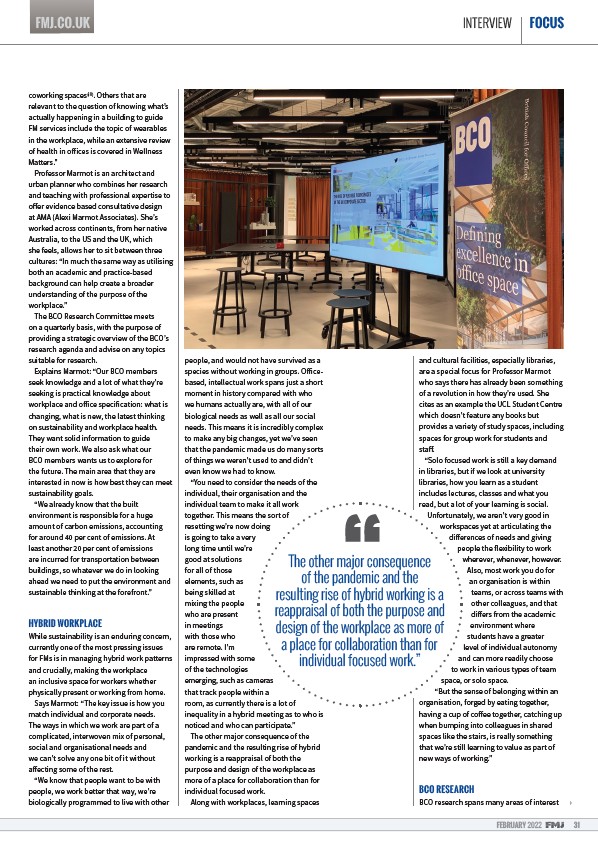
FMJ.CO.UK INTERVIEW FOCUS
FEBRUARY 2022 31
coworking spaces(iii). Others that are
relevant to the question of knowing what’s
actually happening in a building to guide
FM services include the topic of wearables
in the workplace, while an extensive review
of health in ož ices is covered in Wellness
Matters.”
Professor Marmot is an architect and
urban planner who combines her research
and teaching with professional expertise to
ož er evidence based consultative design
at AMA (Alexi Marmot Associates). She’s
worked across continents, from her native
Australia, to the US and the UK, which
she feels, allows her to sit between three
cultures: “In much the same way as utilising
both an academic and practice-based
background can help create a broader
understanding of the purpose of the
workplace.”
The BCO Research Committee meets
on a quarterly basis, with the purpose of
providing a strategic overview of the BCO’s
research agenda and advise on any topics
suitable for research.
Explains Marmot: “Our BCO members
seek knowledge and a lot of what they’re
seeking is practical knowledge about
workplace and ož ice specification: what is
changing, what is new, the latest thinking
on sustainability and workplace health.
They want solid information to guide
their own work. We also ask what our
BCO members wants us to explore for
the future. The main area that they are
interested in now is how best they can meet
sustainability goals.
“We already know that the built
environment is responsible for a huge
amount of carbon emissions, accounting
for around 40 per cent of emissions. At
least another 20 per cent of emissions
are incurred for transportation between
buildings, so whatever we do in looking
ahead we need to put the environment and
sustainable thinking at the forefront.”
HYBRID WORKPLACE
While sustainability is an enduring concern,
currently one of the most pressing issues
for FMs is in managing hybrid work patterns
and crucially, making the workplace
an inclusive space for workers whether
physically present or working from home.
Says Marmot: “The key issue is how you
match individual and corporate needs.
The ways in which we work are part of a
complicated, interwoven mix of personal,
social and organisational needs and
we can’t solve any one bit of it without
až ecting some of the rest.
“We know that people want to be with
people, we work better that way, we’re
biologically programmed to live with other
people, and would not have survived as a
species without working in groups. Ož icebased,
intellectual work spans just a short
moment in history compared with who
we humans actually are, with all of our
biological needs as well as all our social
needs. This means it is incredibly complex
to make any big changes, yet we’ve seen
that the pandemic made us do many sorts
of things we weren’t used to and didn’t
even know we had to know.
“You need to consider the needs of the
individual, their organisation and the
individual team to make it all work
together. This means the sort of
resetting we’re now doing
is going to take a very
long time until we’re
good at solutions
for all of those
elements, such as
being skilled at
mixing the people
who are present
in meetings
with those who
are remote. I’m
impressed with some
of the technologies
emerging, such as cameras
that track people within a
room, as currently there is a lot of
inequality in a hybrid meeting as to who is
noticed and who can participate.”
The other major consequence of the
pandemic and the resulting rise of hybrid
working is a reappraisal of both the
purpose and design of the workplace as
more of a place for collaboration than for
individual focused work.
Along with workplaces, learning spaces
and cultural facilities, especially libraries,
are a special focus for Professor Marmot
who says there has already been something
of a revolution in how they’re used. She
cites as an example the UCL Student Centre
which doesn’t feature any books but
provides a variety of study spaces, including
spaces for group work for students and
staž .
“Solo focused work is still a key demand
in libraries, but if we look at university
libraries, how you learn as a student
includes lectures, classes and what you
read, but a lot of your learning is social.
Unfortunately, we aren’t very good in
workspaces yet at articulating the
diž erences of needs and giving
people the flexibility to work
wherever, whenever, however.
Also, most work you do for
an organisation is within
teams, or across teams with
other colleagues, and that
diž ers from the academic
environment where
students have a greater
level of individual autonomy
and can more readily choose
to work in various types of team
7Ke otKer PaMor conseTXence
oI tKe SanGePic anG tKe
resXOtinJ rise oI K\EriG ZorNinJ is a
reaSSraisaO oI EotK tKe SXrSose anG
GesiJn oI tKe ZorNSOace as Pore oI
a SOace Ior coOOaEoration tKan Ior
space, or solo space.
“But the sense of belonging within an
inGiYiGXaO IocXseG ZorNƌ
organisation, forged by eating together,
having a cup of což ee together, catching up
when bumping into colleagues in shared
spaces like the stairs, is really something
that we’re still learning to value as part of
new ways of working.”
BCO RESEARCH
BCO research spans many areas of interest